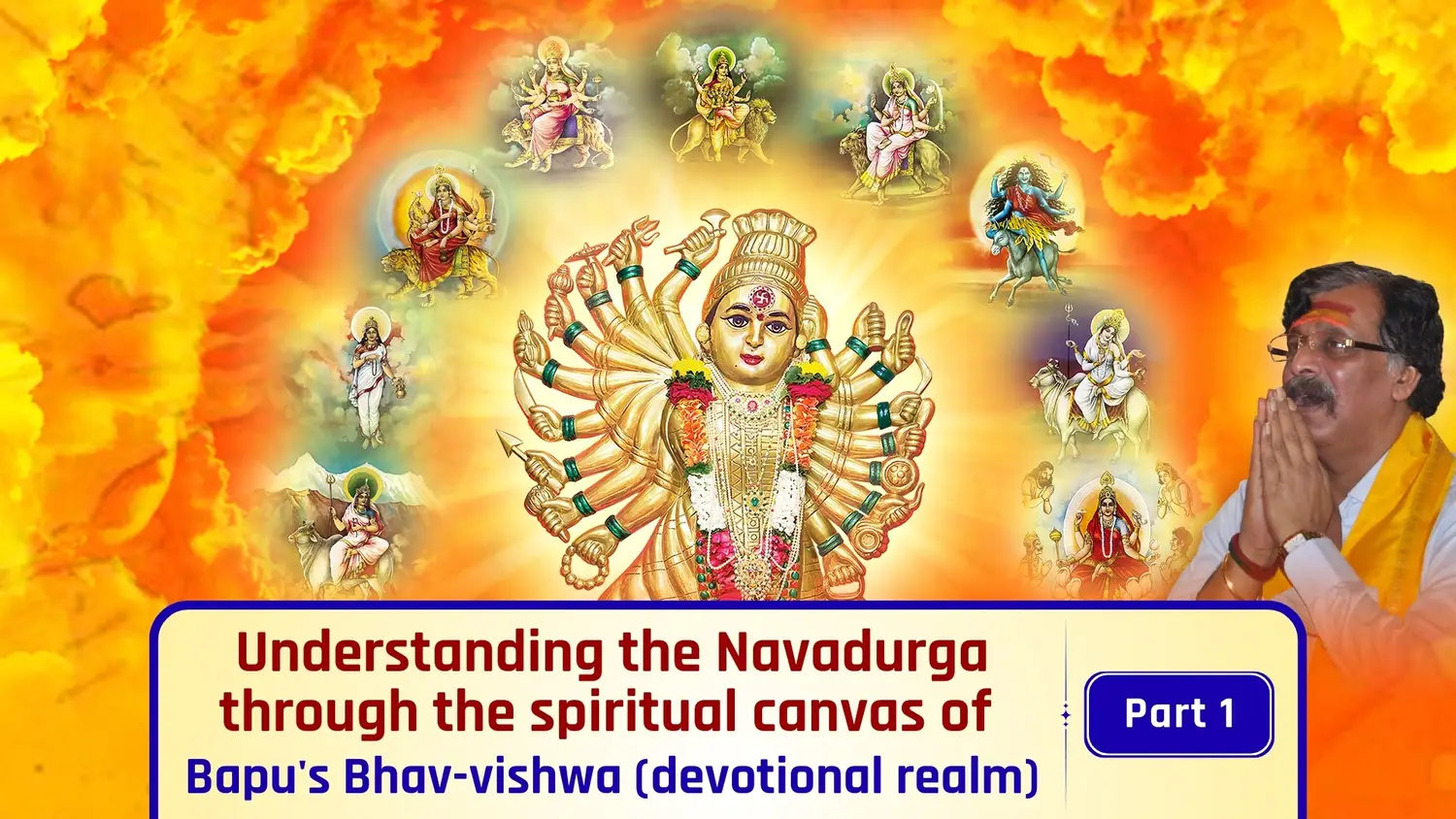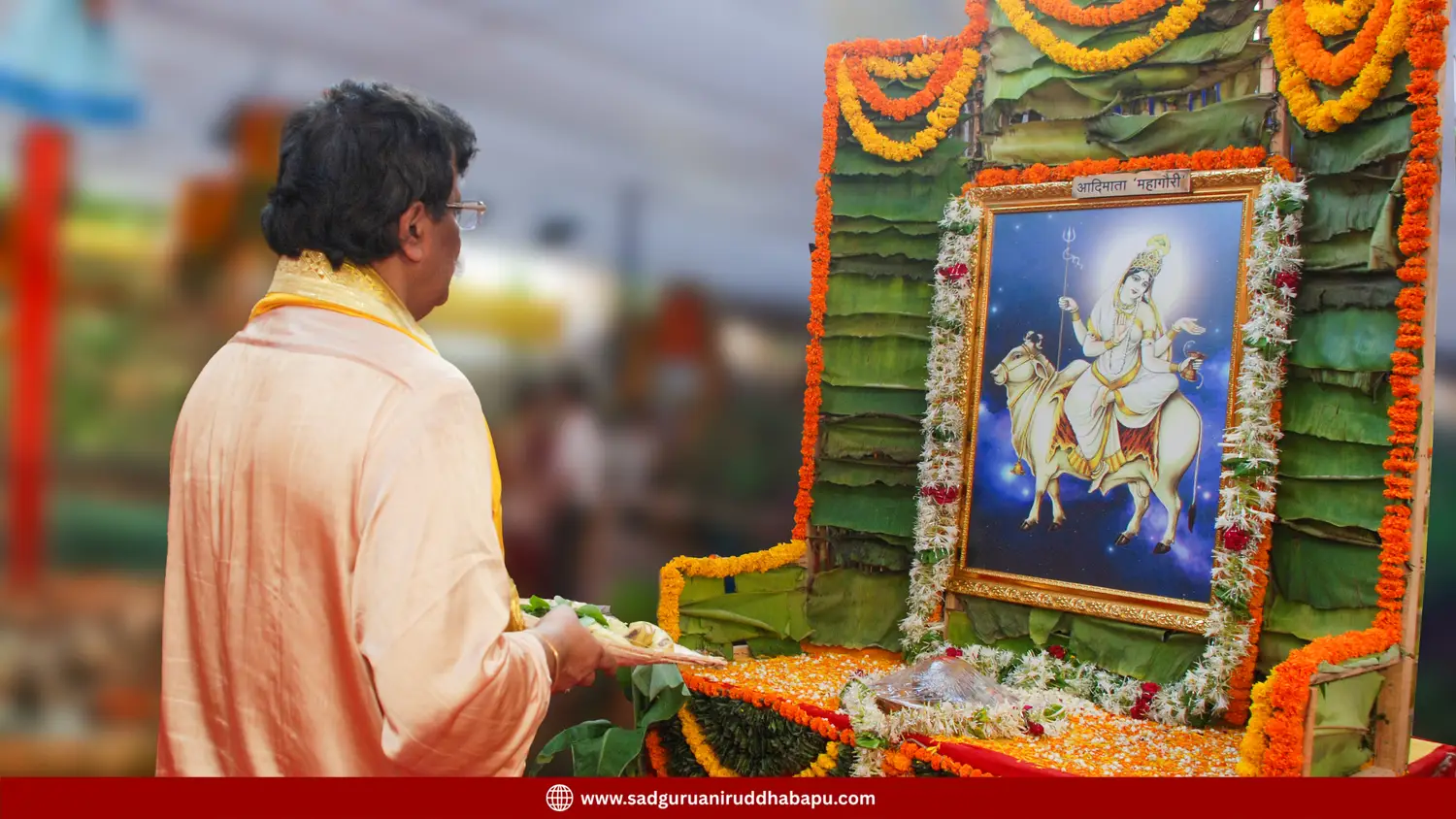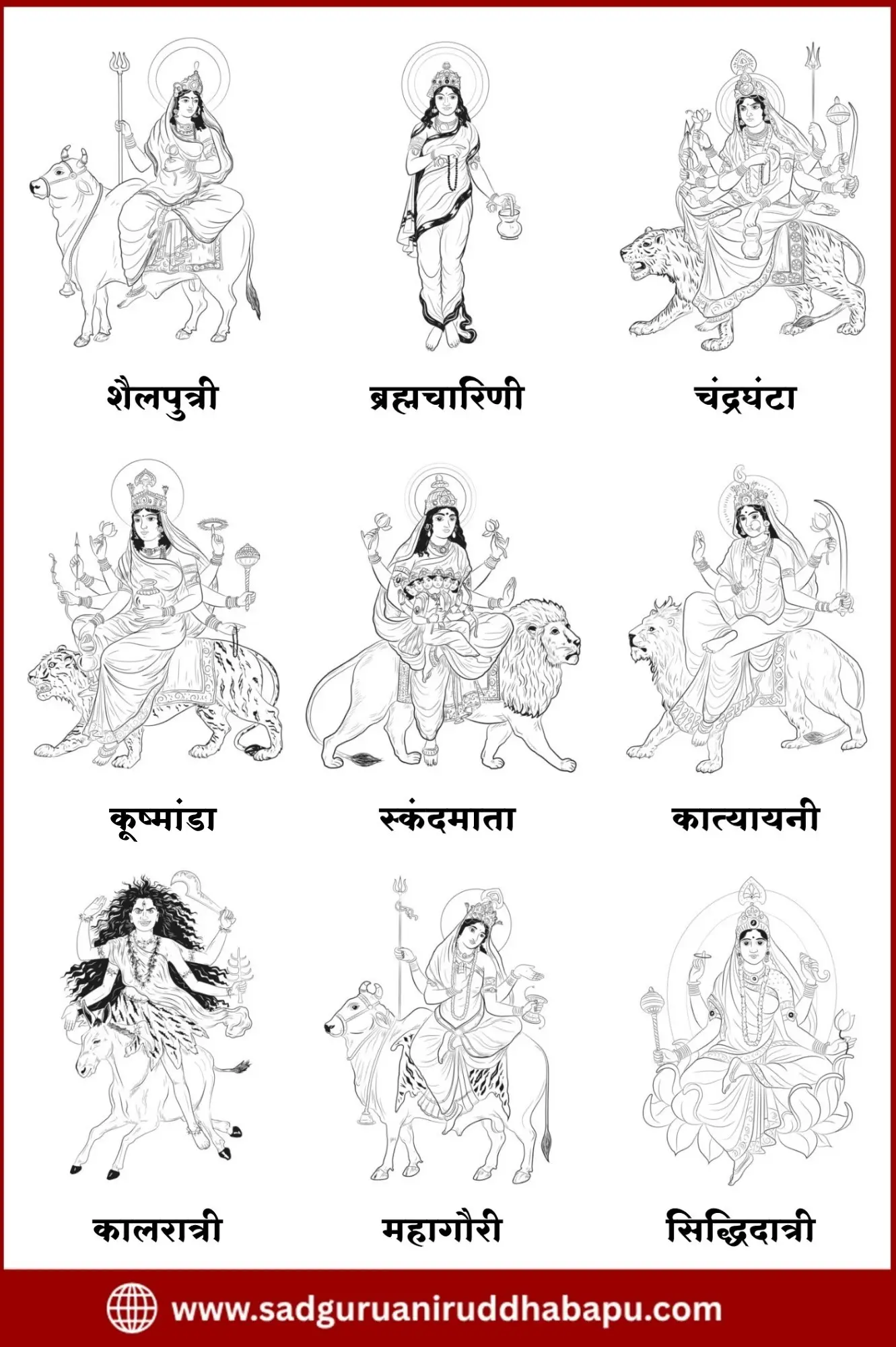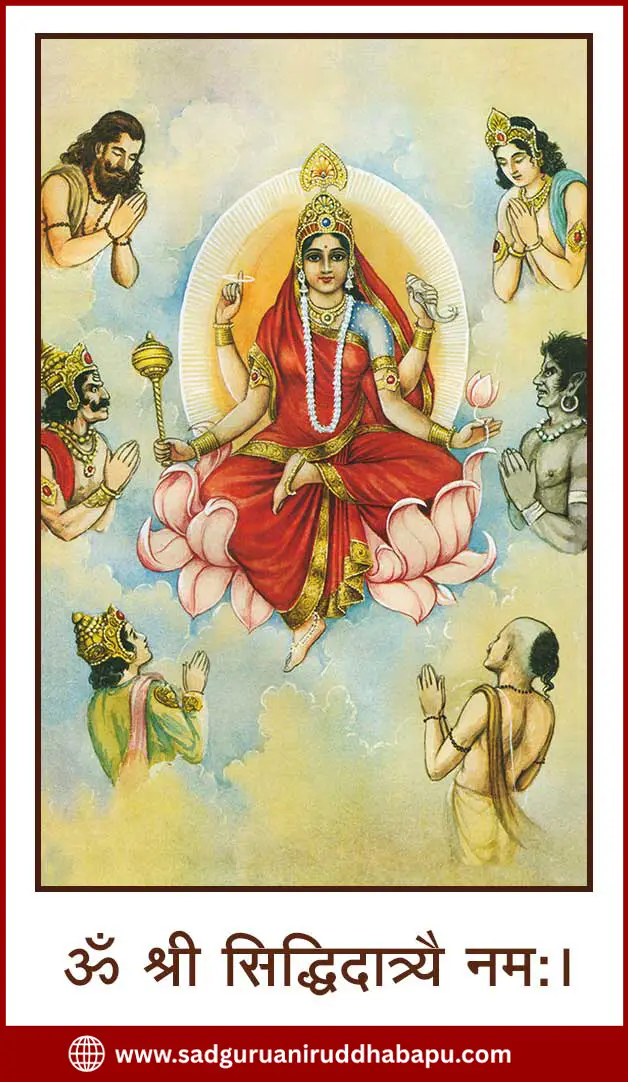Understanding the Navadurga through the spiritual canvas of Bapu's Bhav-vishwa (devotional realm) - Part 1

मराठी हिंदी ગુજરાતી বাংলা తెలుగు ಕನ್ನಡ தமிழ்
As we bid farewell to Bhagwan Ganesha, the bestower of wisdom, Vinayak on Anant Chaturdashi, a gentle feeling of melancholy fills the heart. Yet, within a few days, begins a new journey of devotion and enthusiasm, one that brings fresh energy to our faith — the sacred period of Ashwin Navratri.
At the end of Ashwin Navratri, on the day of Dussehra, Lord Rama defeated Ravana, signifying the victory of good over evil. Therefore, Sadguru Shree Aniruddha has referred to this Navratri as the Ashubhnashini Navratri — the Navratri that destroys inauspiciousness.
During this Navratri, the various forms of Mother Jagadamba are worshipped with devotion. Likewise, in many parts of India, devotees worship the nine forms of Mother Parvati over these nine days — Shailaputri, Brahmacharini, Chandraghanta, Kushmanda, Skandamata, Katyayani, Kalaratri, Mahagauri, and Siddhidatri. These forms of Mother Parvati are collectively known as the ‘Navadurga’.
Through the editorials of the daily newspaper Pratyaksha, Sadguru Shree Aniruddha, with his profound study and contemplation, has beautifully and simply explained the greatness of these Navadurga. These editorials are not merely informative; they make bhakti more meaningful and help us truly understand the essence of the Navadurga.
From today onwards, we are making blog posts based on these editorials available for everyone. Let us all join together on this journey of bhakti and faith.
Reference: An editorial series, titled ‘Tulsipatra’ published in Sadguru Shree Aniruddha Bapu’ daily 'Pratyaksha' article no. 1380 & 1381."
"In Tulsipatra – 1380, Sadguru Shree Aniruddha Bapu writes –"
After narrating the story of the establishment of Shree Moolark Ganesh in the Satyayuga, Brahmavadini Lopamudra looked at Mother Parvati with admiration.
The Annapurna Parvati then said to Lopamudra, “O Brahmavadini Lopamudra! How beautifully you have narrated this story!
While explaining the first stage of ShreeShambhavi Vidya, you have made it so easy for the Shraddhavans to take the very first step.”
With great affection, the Shiva-Rishi Tumburu then asked Mother Parvati, “O Mother! Brahmavadini Lopamudra has fulfilled her responsibility. But the explanation of many aspects of this first stage can only come from you. Because in both your incarnations, i.e., as Daksha’s daughter Sati and as Himavan’s daughter Parvati, you have traversed every step of this Shambhavi Vidya through penance, and You did this by taking a human birth in order to attain the ParamShiva in His subtlest form.
And it is precisely because of this penance of yours that your marriage with Shiva took place, and Skanda and Ganapati were born.”
Completely agreeing with the words of Sage Tumburu, Devarshi Narada said,
“O Parvati! The Mother of devotees, at the end of your penance, you once again received this Shambhavi Vidya directly from Shiva Himself.
Thus, you became the very first initiate, the first worshipper, and the first practitioner of Shambhavi Vidya.
Paramshiva explained to you every intricate detail of Shambhavi Vidya in depth.
Therefore, on behalf of everyone, I pray that while Brahmavadini Lopamudra continues to explain Shambhavi Vidya, you should, whenever you wish, begin to speak on your own, knowing the feelings in all our hearts.”
“O Parvati! You are such a wondrous daughter of the Adimata that every action of yours reflects only the path of Shambhavi Vidya.
And therefore, your nine forms during the penance (Tapashcharya) of Shambhavi Vidya are renowned as the Navadurga:
1) Shailaputri, 2) Brahmacharini, 3) Chandraghanta, 4) Kushmanda,
5) Skandamata, 6) Katyayani, 7) Kalaratri, 8) Mahagauri, 9) Siddhidatri.
Turning then to all the sages, Devarshi Narada said, “The worship of these nine forms of Parvati is performed during Navaratri, one form on each day.
For just as the “ShriSukta” is the combined stotra of BhaktaMata Lakshmi and the Adimata Mahalakshmi, in the same way, Navaratri worship is the combined worship of BhaktaMata Parvati and the Adimata Durga. And among these Navadurgas, the form of “Brahmacharini” itself is the symbol of discipline and conduct of the Shambhavi Vidya.”
At the end of her penance, upon attaining Paramshiva, she expressed only two wishes to her husband:
that her love for Shiva should remain eternal and inexhaustible, and
that, just like Paramshiva, all her actions too should be dedicated solely to the service of the Adimata.

While seeking this boon from Shiva, Parvati was so deeply absorbed in the oneness with Paramshiva and with the feeling that He was the “child of the Adimata,” that she became completely one with Shiva Himself. As a result, this very Parvati, who was dusky in complexion by birth, transformed into the white, fair and radiant Mahagauri, with the bull as her vehicle.
The Adimata lovingly accepted Parvati’s sentiment of love and, in turn, bestowed upon her the form of Siddhidatri—the ninth form among the Navadurgas, which is the simpler manifestation of Mahadurga’s own Siddheshwari form.
At the same moment, it was declared that this Siddhidatri Parvati herself was the embodiment of the Shambhavi Vidya.
Hearing Devarshi Narada’s words which were brimming with affection for the bhaktas, Parvati, with the permission of the Adimata, assumed the form of Siddhidatri and began to speak. But Shiva RIshi Tumburu, with great humility and love, gently interrupted her so that all the Shraddhavans could first be introduced to the forms of Navadurga.

"In Tulsipatra – 1381, Sadguru Shree Aniruddha Bapu writes –"
While learning about the various forms of Parvati’s Navadurga, everyone on Mount Kailash was so delighted and overjoyed that it seemed as though an ocean of bliss had spread all around.
At this moment, Brahmavadini Lopamudra once again began to speak, “O great Shraddhavans! To ensure that the worship of Shambhavi Vidya proceeds smoothly without any obstacles from the first step to the eighteenth step, the worship of Moolark Ganesh has been prescribed.

This is because, during the worship of Shambhavi Vidya, no errors—whether in Ahar (intake), Vihar (wandering), Achar (conduct) and Vichar (thoughts) should occur. And through the chanting of the Shri Moolark Ganesh mantra, such defects either do not occur at all, or even if they occur slightly, they are immediately removed.
The Shri Moolark Ganesh mantra is as follows:
Om Gam Ganapate Shri Moolark Ganapate Varavarada Shri Aadhar Ganeshaya Namah.
Sarvavighnan Nashay SarvaSiddhim Kuru Kuru Swaha ||
While surrendering to the Adimata and Trivikram on the very first step of Shambhavi Vidya, one must recite this Moolark Ganesh mantra at least five times a day.”
At this point, with great humility, Brahmavadini Katyayani (the first wife of Brahmarshi Yadnyavalkya) asked a question:
“O elder sister Lopamudra! Should this Moolark Ganesh mantra be chanted only by the practitioners of Shambhavi Vidya? Should ordinary devotees not chant it?”
With a delightful smile, Siddhidatri Parvati looked at Brahmavadini Katyayani and said:
“O dear Katyayani! Just like your husband, you too always remain concerned about the well-being of ordinary people. Therefore, I indeed expected this question from you.
Listen, O Katyayani! There is absolutely no objection if any devotee chants this Moolark Ganesh mantra. There is no condition that one must be a practitioner of Shambhavi Vidya to do so.
For in reality, every devotee living life under the aegis of Chandikakul, already becomes a practitioner of the first and the second step of the Shambhavi Vidya.
Moreover, the Adimata, ensures that every devotee of Hers, who offers Her unswerving devotion, practices and performs the Upasana of the Shambhavi Vidya in some birth or the other, according to their progress.
Hearing this response of Mother Parvati, all the young sages and the Shivaganas felt greatly inspired and became even more eager to listen to the next part with deep attention.
Lopamudra said, “The second step of Shri Shambhavi Vidya is to keep doing every task with constant awareness that the entire universe has originated from the Adimata Chandika alone, and therefore, no one can ever know the universe as completely as She does.
Whether performing ordinary daily tasks, engaging in spiritual practice, carrying out special work, or even when something wrong takes place, one must always remember that ‘the Adimata knows it at that very moment.’
Suppose a good or bad thought arises in the seeker’s mind, or there is a mistake in the practice, or even a major blunder happens still, the seekers of the Shambhavi Vidya have no reason to worry, and certainly no reason to be afraid.
The Shraddhavan-seeker should simply, with utmost openness, tell the Adimata and Trivikram in their mind whatever they feel and then say ‘Ambadnya’ five times.”
At this stage, unable to hold back, one young sage exclaimed with great wonder and love,
“What! Is it really this simple?”
Lopamudra looked at that young sage with deep affection and said, “Yes! But it must be done with the same natural, simple, and innocent feeling with which you have asked this question, nothing more.”
However, the young sage still wished to ask one more question. This time, he properly sought permission and then said,
“O Brahmavadini Lopamudra! It is only because of the loving and tender affection of you all that I have gathered courage to ask this question.
There are still many flaws within me. Many kinds of fears and worries trouble me from time to time. I have not yet been freed from the six foes of spirituality and good life—temptation, anger, and so on.”
The young sage said, “In fact, I am no longer a ‘Rishikumar,’ for according to the disciplines of the Gurukuls, I have now become a ‘Rishi.’ That is why I feel it is both absolutely essential for me to practice the Shambhavi Vidya and yet, at the same time, I feel afraid to do so.
Will I be able to practice Shambhavi Vidya so that I can remove the Tamasi Tamoguna within me?”
Brahmavadini Lopamudra looked at him and said, “O child! The very yearning with which you are asking this question is exactly what is most necessary on the second step of the Shambhavi Vidya.
And remember, all of you have already firmly climbed the first step. That is why I can now explain the subsequent steps to you.
O all you Shraddhavans gathered here! The story of the battle between Shiva and Tripurasura is nothing but the narrative form of the Shambhavi Vidya itself, and each one of you was a part of that very history.”
Hearing these words, the young sage humbly placed his head at her feet and then stood up. At that moment, his face was shining with the brilliance of the sun’s rays that glimmered at the sunrise.
Looking at his face, all the young sages and Shivaganas expressed their amazement. Seeing this, Lopamudra asked him, “Do you know the reason why the radiance of rays emitted from the rising sun has spread across your face?”
The young sage humbly replied, “No.”
At this point, Brahmarshi Kashyapa rose to his feet and said,
“O revered Brahmavadini Lopamudra! This young sage’s name is ‘Gautama.’ It was I who named him so, because his nature is as intense as the blazing midday sun, and he has performed his penances with the same intensity.
But he is so stringent with his sense of duty even with himself that he does not forgive even the smallest mistake of his own and keeps performing penance for it. He has become a great scholar of the science of ‘sun-rays.’ Because of his intense commitment to truth, righteousness, and dharma, I have named him ‘Gautama’ (Gau = sun-rays).
O dear disciple Gautama! Your yearning too is just as intense. That is why this radiance of the sun has spread across your face.”
Sage Gautama then asked the Mother of devotees, Parvati in a modest manner, “O Mother of devotees Siddhidatri, when will this intensity in my nature finally go away?”
Parvati smiled and replied, “When a lifeless stone takes the form of a living woman before your eyes.”

